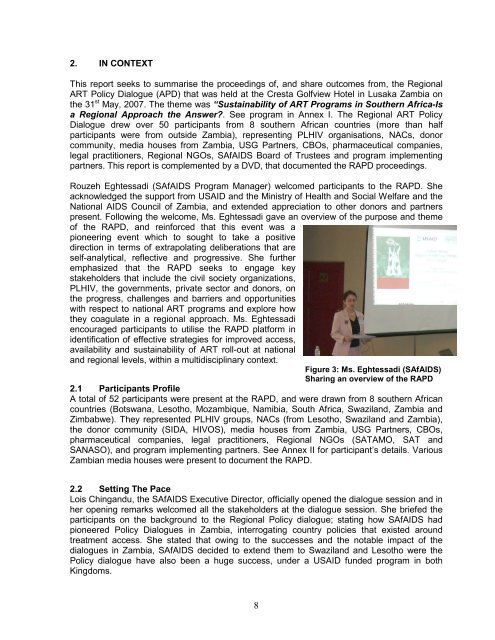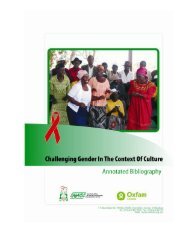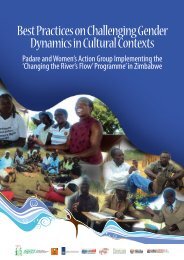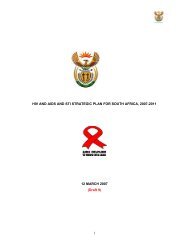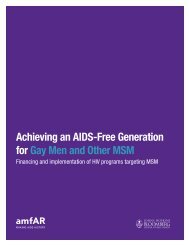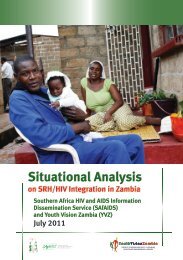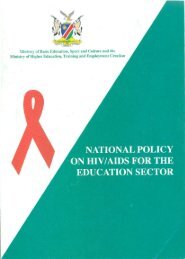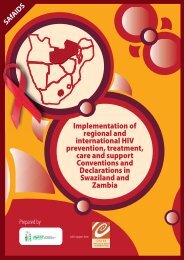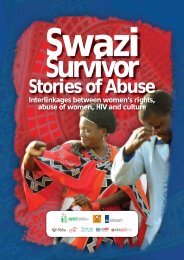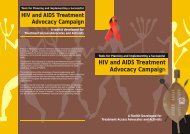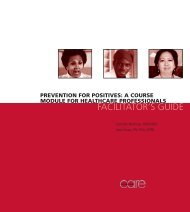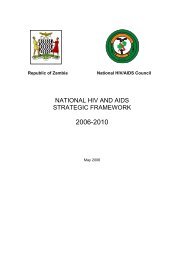Regional ART Policy Dialogue Report.pdf - SAfAIDS
Regional ART Policy Dialogue Report.pdf - SAfAIDS
Regional ART Policy Dialogue Report.pdf - SAfAIDS
You also want an ePaper? Increase the reach of your titles
YUMPU automatically turns print PDFs into web optimized ePapers that Google loves.
2. IN CONTEXTThis report seeks to summarise the proceedings of, and share outcomes from, the <strong>Regional</strong><strong>ART</strong> <strong>Policy</strong> <strong>Dialogue</strong> (APD) that was held at the Cresta Golfview Hotel in Lusaka Zambia onthe 31 st May, 2007. The theme was “Sustainability of <strong>ART</strong> Programs in Southern Africa-Isa <strong>Regional</strong> Approach the Answer?. See program in Annex I. The <strong>Regional</strong> <strong>ART</strong> <strong>Policy</strong><strong>Dialogue</strong> drew over 50 participants from 8 southern African countries (more than halfparticipants were from outside Zambia), representing PLHIV organisations, NACs, donorcommunity, media houses from Zambia, USG Partners, CBOs, pharmaceutical companies,legal practitioners, <strong>Regional</strong> NGOs, <strong>SAfAIDS</strong> Board of Trustees and program implementingpartners. This report is complemented by a DVD, that documented the RAPD proceedings.Rouzeh Eghtessadi (<strong>SAfAIDS</strong> Program Manager) welcomed participants to the RAPD. Sheacknowledged the support from USAID and the Ministry of Health and Social Welfare and theNational AIDS Council of Zambia, and extended appreciation to other donors and partnerspresent. Following the welcome, Ms. Eghtessadi gave an overview of the purpose and themeof the RAPD, and reinforced that this event was apioneering event which to sought to take a positivedirection in terms of extrapolating deliberations that areself-analytical, reflective and progressive. She furtheremphasized that the RAPD seeks to engage keystakeholders that include the civil society organizations,PLHIV, the governments, private sector and donors, onthe progress, challenges and barriers and opportunitieswith respect to national <strong>ART</strong> programs and explore howthey coagulate in a regional approach. Ms. Eghtessadiencouraged participants to utilise the RAPD platform inidentification of effective strategies for improved access,availability and sustainability of <strong>ART</strong> roll-out at nationaland regional levels, within a multidisciplinary context.Figure 3: Ms. Eghtessadi (<strong>SAfAIDS</strong>)Sharing an overview of the RAPD2.1 Participants ProfileA total of 52 participants were present at the RAPD, and were drawn from 8 southern Africancountries (Botswana, Lesotho, Mozambique, Namibia, South Africa, Swaziland, Zambia andZimbabwe). They represented PLHIV groups, NACs (from Lesotho, Swaziland and Zambia),the donor community (SIDA, HIVOS), media houses from Zambia, USG Partners, CBOs,pharmaceutical companies, legal practitioners, <strong>Regional</strong> NGOs (SATAMO, SAT andSANASO), and program implementing partners. See Annex II for participant’s details. VariousZambian media houses were present to document the RAPD.2.2 Setting The PaceLois Chingandu, the <strong>SAfAIDS</strong> Executive Director, officially opened the dialogue session and inher opening remarks welcomed all the stakeholders at the dialogue session. She briefed theparticipants on the background to the <strong>Regional</strong> <strong>Policy</strong> dialogue; stating how <strong>SAfAIDS</strong> hadpioneered <strong>Policy</strong> <strong>Dialogue</strong>s in Zambia, interrogating country policies that existed aroundtreatment access. She stated that owing to the successes and the notable impact of thedialogues in Zambia, <strong>SAfAIDS</strong> decided to extend them to Swaziland and Lesotho were the<strong>Policy</strong> dialogue have also been a huge success, under a USAID funded program in bothKingdoms.8


